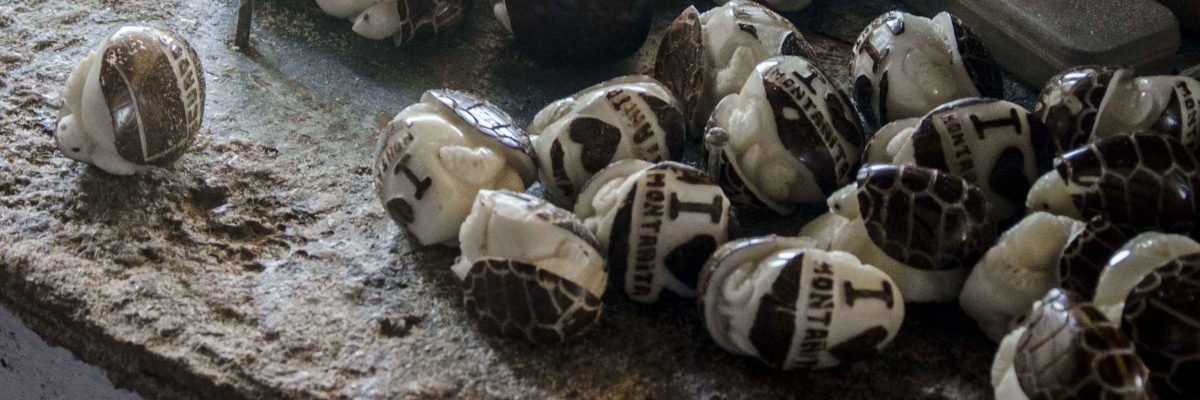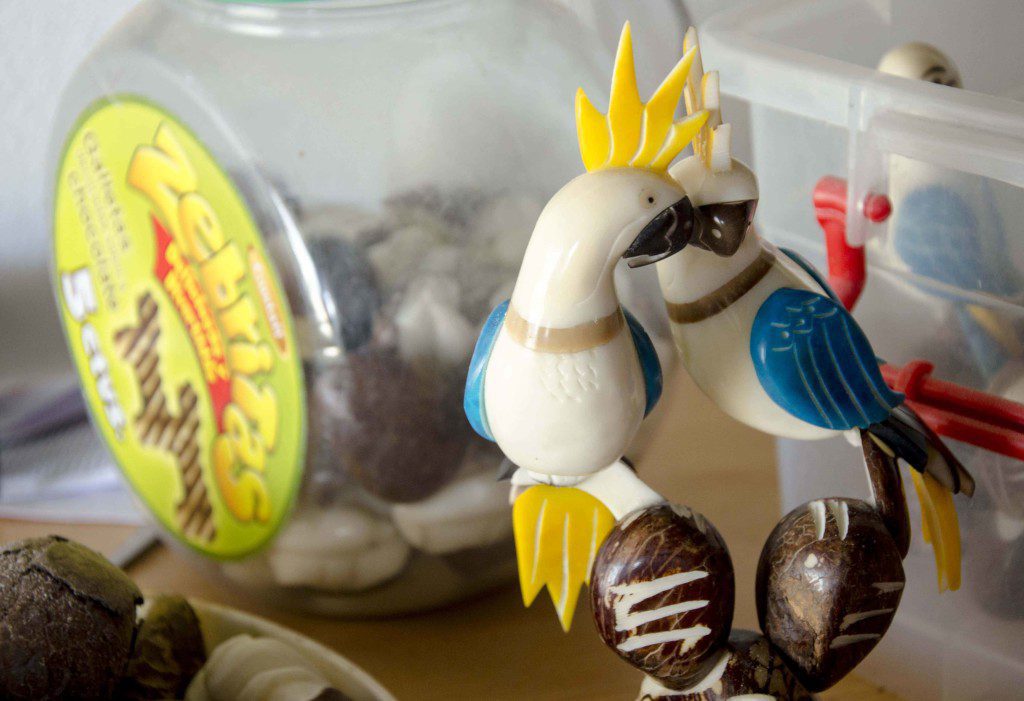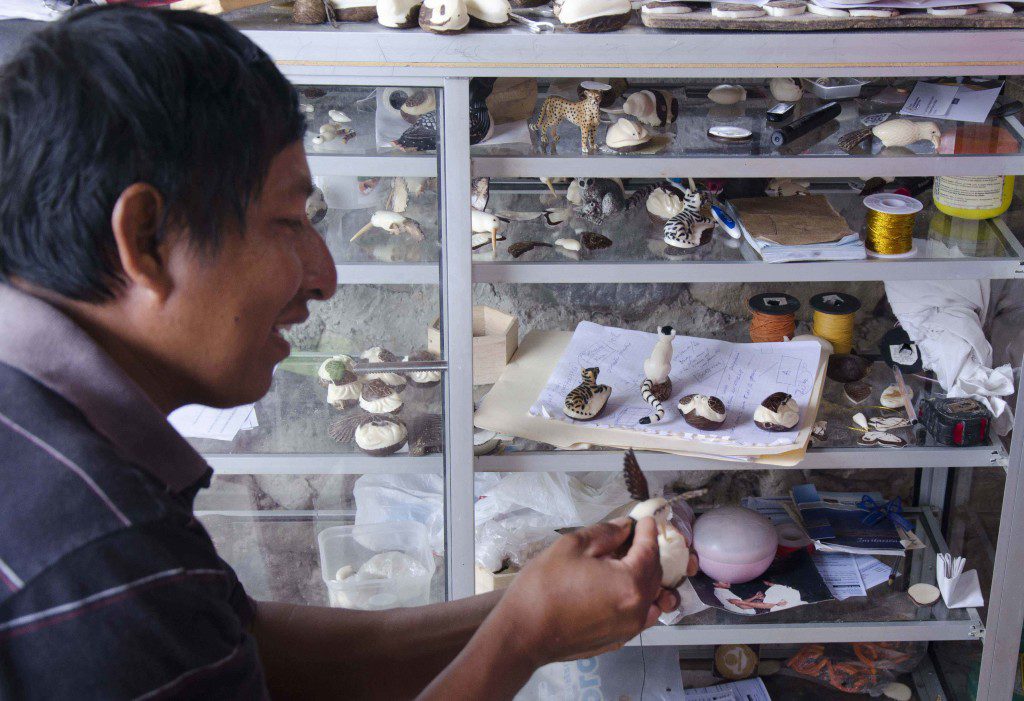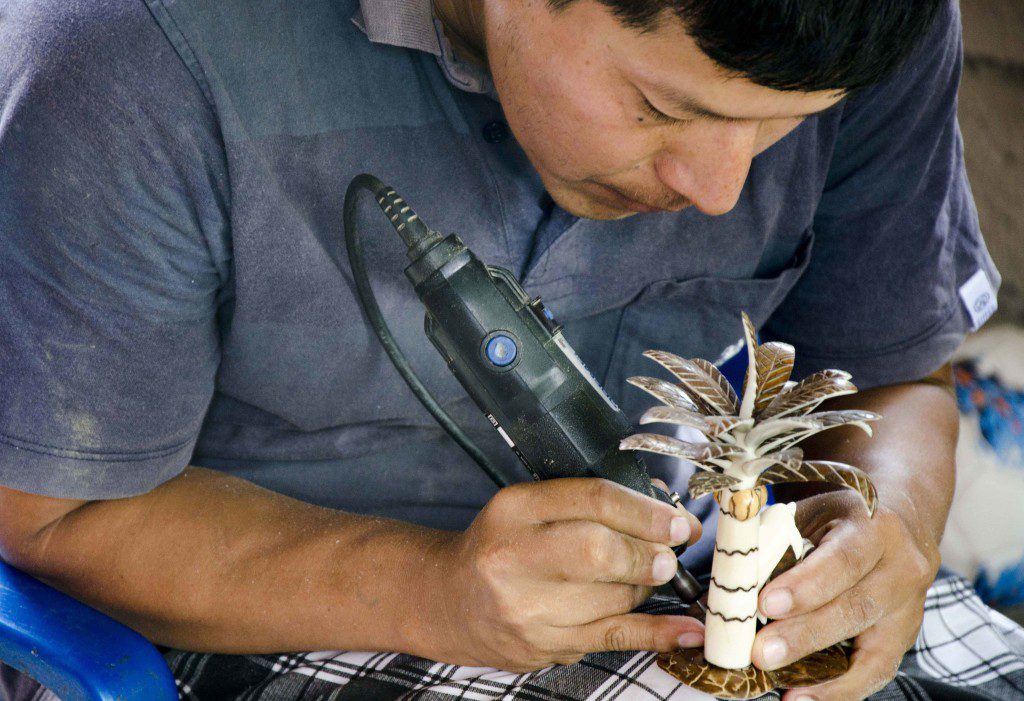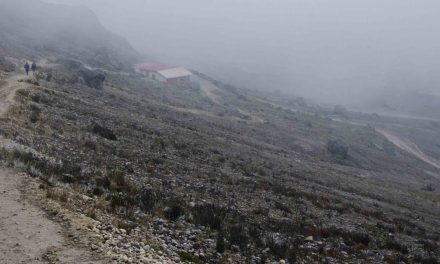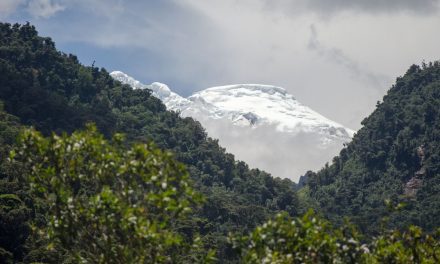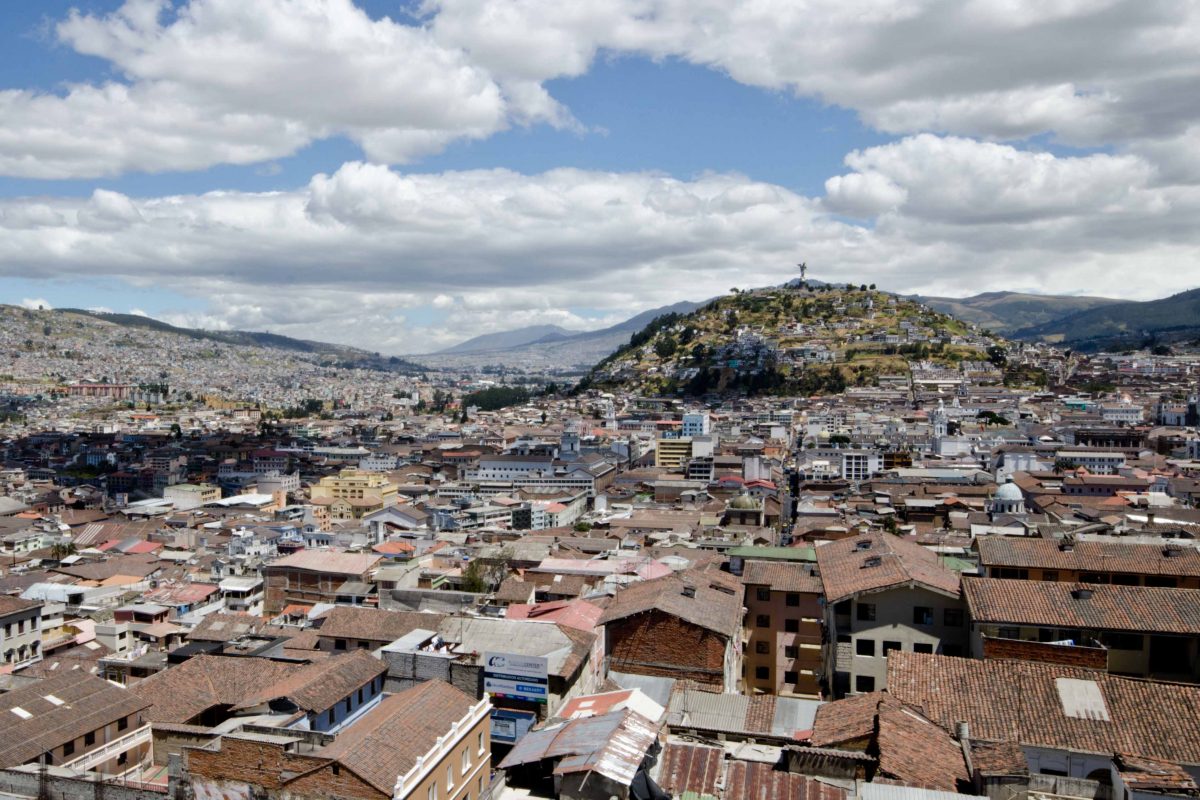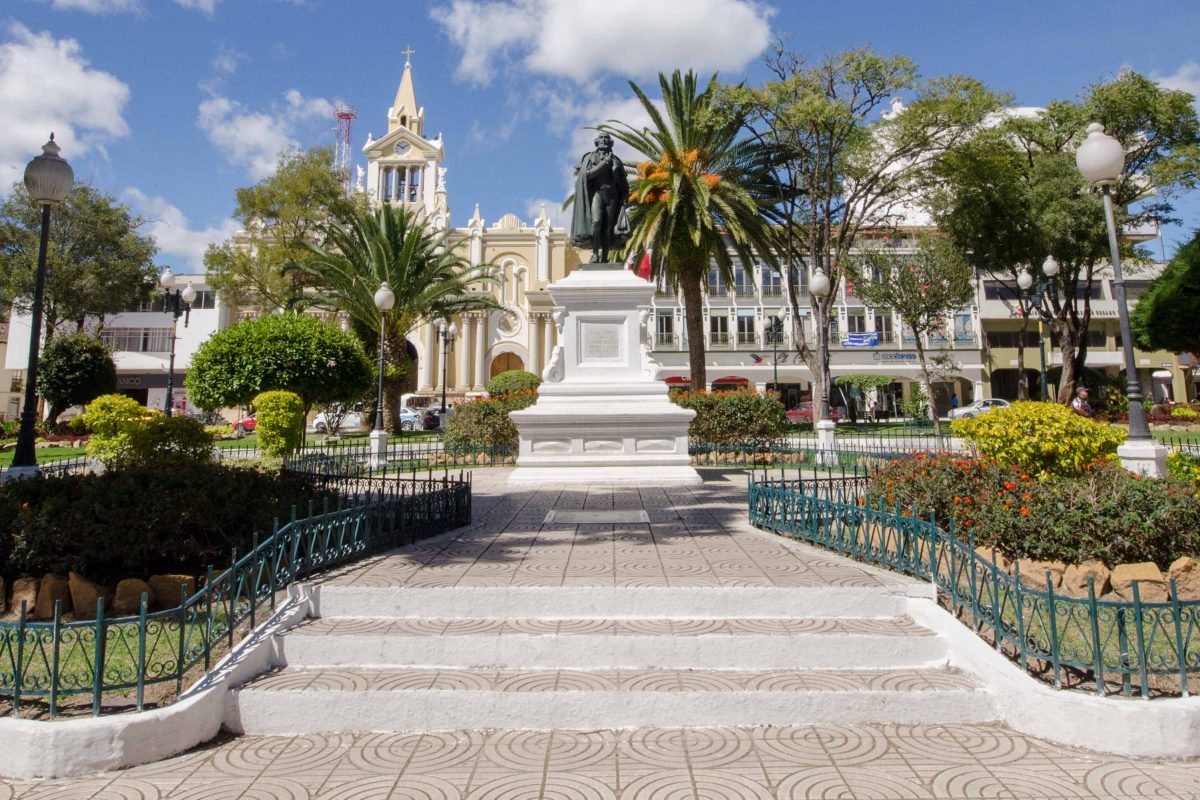As responsible travelers evolve, so do the stories we share.
This article is part of our living archive — trusted content we continue to care for.
First published on March 26, 2015 • Last updated on April 3, 2018.
Dos Mangas has a secret waiting to be told to a wider audience. Currently it is known only by Ecuadorians and even many of them don’t know of the treasures trove just a few kilometers off the Ruta del Sol.
Dos Mangas is a small, unassuming village bisected by the obligatory dirt road lined by a few homes, most that double as a place of business. We arrive on a quiet Saturday morning, when everyone is either running errands or has driven a few miles away to enjoy the sun and surf of nearby Montañita. Careful inspection revealed a lone woman swinging in a hammock in front of her home and she was able to point us towards the purpose of our visit, a place to buy carved tagua.
 Of course, you may not know what tagua is! In the US and Europe, it’s best known as vegetable ivory. It is a nut found in trees that grow along the coast and in the jungles of Ecuador. A single pod is about a foot across and can hold dozens of nuts inside. The most common variety has a brown, veiny outside and a creamy white interior. When it is carved and all the natural brown removed, it can look like turn-of-the-century ivory-colored Bakelite.
Of course, you may not know what tagua is! In the US and Europe, it’s best known as vegetable ivory. It is a nut found in trees that grow along the coast and in the jungles of Ecuador. A single pod is about a foot across and can hold dozens of nuts inside. The most common variety has a brown, veiny outside and a creamy white interior. When it is carved and all the natural brown removed, it can look like turn-of-the-century ivory-colored Bakelite.
The first workshop we visit is right on main street and happens to be just behind our hammock sitter. Inside a room lit only by natural daylight creeping in through the wide open, glass-less window and open doorway, we find a woman working with a Dremel. She uses the handheld drill to carve intricate shapes for the tourist market, making small amulets of Ecuadorian wildlife inscribed with the words, I Love Montañita. She proudly shows us her work but says she has none for sale. All of her pieces are being made for shops along the coast and are promised to vendors.
But she points us towards another artisan’s house, up a small alleyway between two other homes. There we find someone willing to show his work, though he wasn’t really prepared for customers either. He has a glass case with a few finished items but most need a little bit of this or a little bit of that to actually be sold. He’s convinced to part with a few items that our friends find hidden among the unfinished works. One piece is actually what we would call a second, not quite perfect, but I fall in love with it anyway, a little carved hedgehog, his face ivory white and his body the natural brown of the outside layer of tagua.
 But we’re still not satisfied. We’ve come to buy tagua and are a little disappointed not to find artist after artist with shelves full of finished items to sell. We’re directed to one more home. As we approach, we notice no one in the garden or in the small patio that doubles as a workshop. We notice only guinea pigs that are scrambling to hide from our view, just in case we get any funny ideas about eating them for lunch. But a polite, Hola, Buenos Días! attracts the woman of the house. She, too, explains that she has very little for sale as most business nowadays is for the markets along the coast.
But we’re still not satisfied. We’ve come to buy tagua and are a little disappointed not to find artist after artist with shelves full of finished items to sell. We’re directed to one more home. As we approach, we notice no one in the garden or in the small patio that doubles as a workshop. We notice only guinea pigs that are scrambling to hide from our view, just in case we get any funny ideas about eating them for lunch. But a polite, Hola, Buenos Días! attracts the woman of the house. She, too, explains that she has very little for sale as most business nowadays is for the markets along the coast. 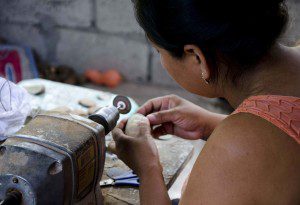 But the more we talk, the more she remembers little pieces hidden here and there. First, the jewelry comes out, delicately carved earrings with matching pendants to hang on a necklace and a bracelet or two. Then a hummingbird ornament that is pure creamy white. When I express interest in it and my friend does two, a second hummingbird appears, this one creamy white on its front but its wings the nut-colored brown of the un-carved tagua. The pièce de résistance is a tall, intricate palm that is built from both tagua and the cacao husks and a solid creamy white dolphin perched near its base. Pure Ecuadorian kitsch. When our friend decides to buy it, he asks for the name of Ecuador to be added to the piece and our kindly hostess calls her husband to get to work. As he carves letters into the base of the palm, she buffs and polishes our other purchases.
But the more we talk, the more she remembers little pieces hidden here and there. First, the jewelry comes out, delicately carved earrings with matching pendants to hang on a necklace and a bracelet or two. Then a hummingbird ornament that is pure creamy white. When I express interest in it and my friend does two, a second hummingbird appears, this one creamy white on its front but its wings the nut-colored brown of the un-carved tagua. The pièce de résistance is a tall, intricate palm that is built from both tagua and the cacao husks and a solid creamy white dolphin perched near its base. Pure Ecuadorian kitsch. When our friend decides to buy it, he asks for the name of Ecuador to be added to the piece and our kindly hostess calls her husband to get to work. As he carves letters into the base of the palm, she buffs and polishes our other purchases.
At the end of our transactions, we ask about visiting again and our friend wants to call ahead, to request items in advance. The couple is thrilled by the idea and share their names and cellphone numbers so that we, and you too, can call and place an order before coming to visit. We don’t recommend coming on a Saturday without calling ahead. But mid-week would probably find more tagua artists at home and at work. And we do recommend speaking some Spanish. At the very least, bring a dictionary. We do believe that with more visitors, more artists will offer items for direct sale.
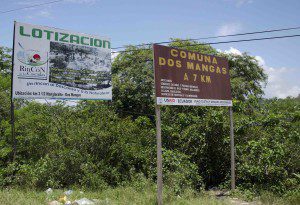 To reach Dos Mangas, you will need to drive to the coast along the Ruta del Sol. If you are heading north from Salinas, the sign is more easily seen than driving south. Just be on the lookout for it in between the small town of Valdivia and the famous surf town of Montañita. The sign is rather unassuming, advertising some hiking trails and artesanias but in big white letters it says Dos Mangas, 7km.
To reach Dos Mangas, you will need to drive to the coast along the Ruta del Sol. If you are heading north from Salinas, the sign is more easily seen than driving south. Just be on the lookout for it in between the small town of Valdivia and the famous surf town of Montañita. The sign is rather unassuming, advertising some hiking trails and artesanias but in big white letters it says Dos Mangas, 7km.
 When you arrive in town, you will turn slightly to the left and be on a street that rises sharply uphill. If you drove to the end, it would dead end in a big dirt lot. But the artisans photographed for this piece live on the first road to the left. It looks more like a driveway. If in doubt, just start asking about Talleres de Tagua (tagua workshops) and one of the friendly locals will be willing to point the way.
When you arrive in town, you will turn slightly to the left and be on a street that rises sharply uphill. If you drove to the end, it would dead end in a big dirt lot. But the artisans photographed for this piece live on the first road to the left. It looks more like a driveway. If in doubt, just start asking about Talleres de Tagua (tagua workshops) and one of the friendly locals will be willing to point the way.
If you would like to call ahead to order a specific items, you can contact either Luis Alejandro at 0993080220 or his wife, Eliana Alejandro at 0988253526.
Dos Mangas
Information For Your Trip
Dos Mangas is a very small town. On the weekends, most artists are away selling their goods along the coast. Your best is to arrive mid-week or to call in advance.
- Direction by Car, use WAZE and enter Comuna Dos Mangas, Ecuador.
- Direction by Public Transportation Your best bet is to hire a taxi from Montañita or Valdivia

